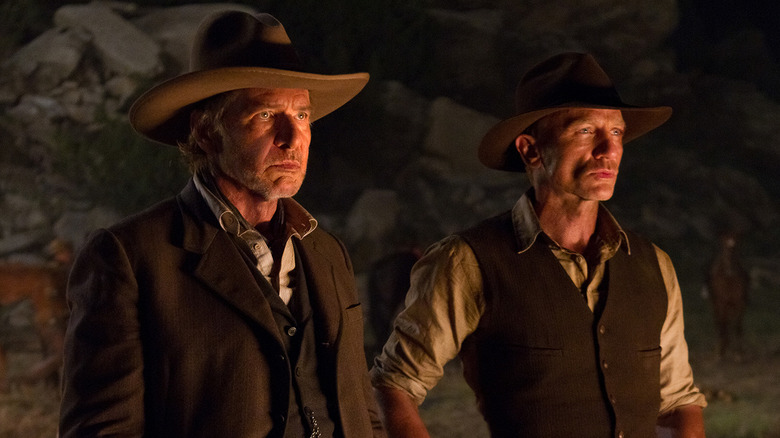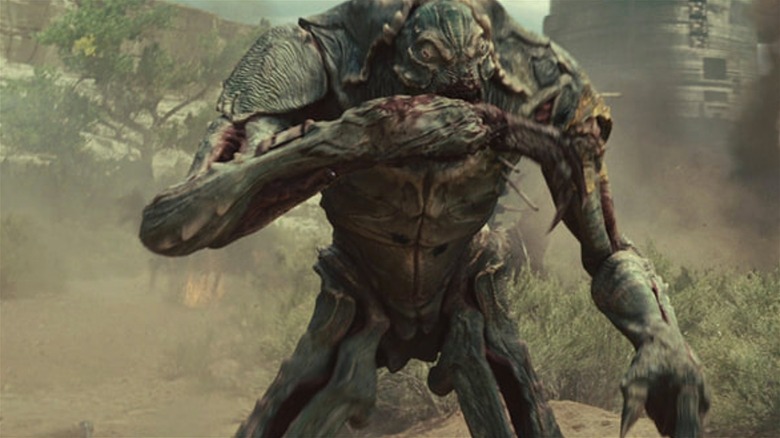Input From Steven Spielberg Completely Changed Cowboys & Aliens' Main Antagonist
In 1997, Platinum Studios co-founder and chairman Scott Mitchell Rosenberg came up with a unique genre-mash concept. What if classic Western tropes were infused with a gritty alien invasion storyline?
This idea birthed the graphic novel "Cowboys & Aliens," where gunslingers Zeke Jackson and Verity Jones witness the crash-landing of an alien spaceship during a caravan ambush. The aliens that disembark the ship are not the friendly, benevolent type — this is a race bent on invading and conquering Earth by destroying everything they set their sights on. Now, it is up to the cowboys to work together with the local natives to defeat the aliens at all costs, even if it means adapting to their superior, futuristic weapons to nudge the odds in their favor.
Although the one-sheet for Rosenberg's graphic novel was always geared toward a big-budget film adaptation, it wasn't until 2011 that the Jon Favreau-helmed "Cowboys & Aliens" was released, with Steven Spielberg and Ron Howard (among others) serving as executive producers. Favreau's adaptation tweaks the tale a bit, with amnesiac outlaw Jake Lonergan (Daniel Craig) waking up in a desert in New Mexico and being immediately hounded by various forces on account of him being a wanted man. Colorful characters converge, including vicious cattle baron Colonel Woodrow Dolarhyde (Harrison Ford) and mysterious rover Ella Swenson (Olivia Wilde), who end up aiding Lonergan when the aliens suddenly attack the town.
Although most of the alien designs in the film were made keeping reptilian features in mind, Rosenberg told Syfy how Spielberg's creative input about the primary antagonist, namely the über-alien, completely altered the concept of these vicious creatures for the better.
Cowboys & Aliens' menacing, distinguishable villain
At one point in the film, a chunk of Lonergan's memories return, and he realizes that the strange metal bracelet around his wrist is the key to tracking the invaders' mothership. We also glimpse a more aggressive alien in this flashback, who Lonergan had managed to scar deeply after his abduction by the alien group and their attempts to vivisect him. According to Rosenberg, this distinct antagonist was pitched by Spielberg himself, and the creature's design was revised several times to make it appear more menacing among its own kind:
"Just one example of Steven's creative input was his suggestion that the main antagonist alien be more anthropomorphic with distinctive translucent patches on its body. This "über-alien" would be distinct, having a translucent skin with a texture more akin to a soft-shell crab. Steven frequently demonstrated that he had his finger on the pulse of what audiences wanted."
As the aliens had a visceral reaction to being wounded on another planet, the scars of most alien creatures were textured like moldy yellow fungus, while the über-alien's wounds were a deep red. The translucence of its skin was an indicator of its authoritative status — it was unlike the alien infantry leading the charges against humans outside, as it stayed on the mothership to supervise the attacks. There's an almost uncanny, human-like quality to the über-alien, where some parts look fleshy while others appear decidedly otherworldly, "like glass or ice or gelatin-y surface that blends into a dryer area (via FX Guide).
Rosenberg also thanked Howard and Spielberg for their expert advice throughout the process, stating that "they consistently provided lots of input," and "were involved in shaping the direction of the story" since day one, molding "Cowboys & Aliens" into the thrilling action-adventure it is.

